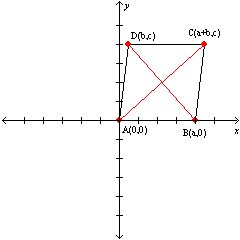
Let a, b, and c represent positive real numbers. Use the figure in which  has vertices at A(0,0), B(a,0), C(a+b,c), and D(b,c) to prove the following theorem.“If the diagonals of a parallelogram are equal in length, then the parallelogram is a rectangle.”
has vertices at A(0,0), B(a,0), C(a+b,c), and D(b,c) to prove the following theorem.“If the diagonals of a parallelogram are equal in length, then the parallelogram is a rectangle.”
What will be an ideal response?
 and
and  are equal in length, then
are equal in length, then  . Applying the Distance Formula,
. Applying the Distance Formula,  so
so  . Also,
. Also,  so that
so that  .
.If 

Squaring, we have 
By subtraction of like terms, 


But 
Because a cannot equal 0 (points A and B would coincide), it is necessary that 
If 
Becuase these vertices lead to the relationship 
You might also like to view...
Find the slope of the curve for the given value of x.y = x2 + 11x - 15, x = 1
A. slope is - 
B. slope is 13
C. slope is -39
D. slope is 
Add.12 + 31 + 21
A. 55 B. 64 C. 46 D. 37
Ralph has budgeted $175 for entertainment. He uses this money to go out on dates for $35 or to go out with his friends for $15. Which budget line equation represents the situation?
A. 35x - 15y = 180 B. 35x + 15y = 180 C. (3x + 5y) = 180 D. 180 - (35x + 15y)
Find the area of the triangle having the given measurements. Round to the nearest square unit.A = 26°, b = 17 meters, c = 5 meters
A. 38 square meters B. 10 square meters C. 40 square meters D. 19 square meters